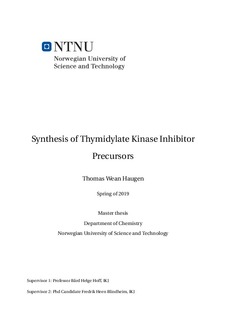| dc.contributor.advisor | Hoff, Bård Helge | |
| dc.contributor.advisor | Blindheim, Fredrik Heen | |
| dc.contributor.author | Haugen, Thomas Wean | |
| dc.date.accessioned | 2019-10-24T14:00:24Z | |
| dc.date.available | 2019-10-24T14:00:24Z | |
| dc.date.issued | 2019 | |
| dc.identifier.uri | http://hdl.handle.net/11250/2624235 | |
| dc.description.abstract | Multimedikamentresistente bakterier er en av de største helseutfordringene verden står oven- for i dag, noe som gjør forskning og utvikling av ny antibiotika viktigere enn noen sinne. Hemming av et av nøkkelenzymene i DNA-syntesen, tymidylatkinase, har de siste årene vist lovende resultater. Dette har gjort at tymidylatkinase-hemmere har blitt et sentralt start- punkt for dette forskningsprosjektet.
Målet med denne masteroppgaven har vært å syntetisere 3-(fluorfenyl)propan-1-aminer med fluor i para-, meta- og orto-posisjon. Aminene skulle videre festes på et større molekyl i en amid-koblingsreaksjon, med et mål om å ende opp i en struktur som den eksisterende tymidylatkinase-hemmeren 6 (Scheme 1). Det er interessant å se om fluoratomets posisjon på fenylringen har en effekt på hemmerens aktivitet og reaktivitet. Ved videre forskning in- nen dette feltet, kan også effekten av å bytte ut fenylgruppen med andre aromater, testes. Heterosykliske ringsystemer kan være et eksempel på dette.
3-(4-Fluorfenyl)propan-1-amin (1a) ble syntetisert i en to-stegs syntese, ved en Horner- Wadsworth-Emmons-reaksjon fra 4-fluorbenzaldehyd, til 3-(4-fluorfenyl)akrylnitril 2a i 48% utbytte. En reduksjon av både alken- og nitril-gruppen med litiumaluminiumhydrid, gav 1a i 41% utbytte. Meta- og orto-analogene, 1b og 1c ble begge syntetisert ved hjelp av samme prosedyre, med henholdsvis 18- og 25% utbytte.
3-Brom-N-(3-fenylpropyl)benzamid (5) ble syntetisert ved å bruke den benzotriasol- og amini- umbaserte koblingsreagenten HATU sammen med Hünigs base i en amid-koblingsreaksjon med 3-brom-benzosyre. Dette gav 5 i 54% utbytte. Scheme 1 viser et skjematisk sammen- drag av masteroppgaven. | |
| dc.description.abstract | Multidrug-resistant bacteria are one of the greatest threats to the human health, and the research on novel antibiotics has never been more important than it is now. The inhibition of one of the key enzymes in the DNA synthesis, thymidylate kinase, has the last couple of years shown some promising results, which has made it the corner stone of this project.
The purpose of this master’s thesis was to synthesize 3-(fluorophenyl)propan-1-amines, with the fluorine in para, meta and ortho position. These amines should later on be attached to a bigger molecule in an amide coupling reaction, for eventually to end up in a structure like the existing thymidylate kinase inhibitor 6 (Scheme 2). It is interesting to see if the fluorine’s position on the phenyl ring will have an effect on the activity and reactivity of the inhibitor. In future work, the effect of other substituents, like heterogeneous aromatic ring systems, could also be an interesting study.
3-(4-Fluorophenyl)propan-1-amine (1a) was synthesized in a two-step synthesis, starting with a Horner-Wadsworth-Emmons reaction of 4-fluorobenzaldehyde, yielding 3-(4-fluorophenyl)acrylonitrile (2a) in 48% yield. A simultaneous reduction of the alkene- and nitrile group with Lithium aluminum hydride, gave 1a in 41% yield. The same proce- dure was used to synthesize the meta and ortho analogues 1b and 1c in 18- and 25% yield, respectively.
3-Bromo-N-(3-phenylpropyl)benzamide (5) was synthesized using the benzotriazole- and aminium based coupling reagent HATU together with Hünig’s base in an amide coupling reaction with 3-bromobenzoic acid, giving 5 in 54% yield. Scheme 2 illustrates a schematic summary of the work done in this master’s thesis. | |
| dc.language | eng | |
| dc.publisher | NTNU | |
| dc.title | Synthesis of Thymidylate Kinase Inhibitor Precursors | |
| dc.type | Master thesis | |
